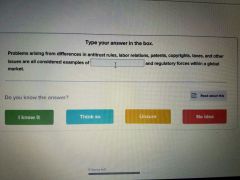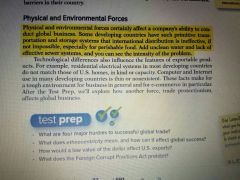![]()
![]()
![]()
Use LEFT and RIGHT arrow keys to navigate between flashcards;
Use UP and DOWN arrow keys to flip the card;
H to show hint;
A reads text to speech;
33 Cards in this Set
- Front
- Back
|
Importing |
Buying products from another country. |
|
|
Exporting |
Selling products to another country. |
|
|
Free trade |
The movement of goods and services among nations without political or economic barriers. |
|
|
Comparative advantage Theory |
Theory that states that a country should sell to other countries those products that is produced most effectively and efficiently, and buy from another countries those products that it cannot produce as effectively or efficiently. |
|
|
Absolute advantage |
The advantage that exists when a country produces a specific product more efficiently than all other countries. |
|
|
Balance of trade |
The total value of a nation's exports compared to its Imports measured over a particular period. |
|
|
Trade Surplus |
A favorable balance of trade occurs when a value of a country's exports exceeds that of its Imports. |
|
|
Trade deficit |
An unfavorable balance of trade occurs when the value of a country's Imports exceeds that of its exports. |
|
|
Balance of payments |
The difference between money coming in to a country from exports and money leaving the country for imports plus money flows from other factors such as tourism foreign aid military expenditures and foreign investment. |
|
|
What are two of the main arguments favoring the expansion of us businesses into Global markets? What are comparative advantage, and what are some examples of this concept at work in the United States? How are a nation's balance of trade and balance of payments determined? What is meant by the term dumping in global trade? |
. |
|
|
Dumping |
Selling products in a foreign country at lower prices than those charged in the producing country. |
|
|
Licensing |
A global strategy in which a firm the licensure allows a foreign company the licensee to produce its product in exchange for a fee a royalty. |
|
|
Contract Manufacturing |
A foreign company's production of private-label goods to which a domestic company that attaches its brand name or trademark, part of a broad category of Outsourcing. |
|
|
Joint venture |
A partnership in which two or more companies often from different countries joined to undertake a major project. |
|
|
Strategic Alliance |
A long-term partnership between two or more companies established to help each company build competitive market advantages. |
|
|
Foreign direct investment FDI |
The buying of permanent property and businesses in foreign Nations. |
|
|
Foreign subsidiary |
A company owned in a foreign country by another company called the parent company. |
|
|
Multinational corporation |
An organization that manufactures and markets products in many different countries and has multinational dog ownership and Multinational management. |
|
|
Sovereign wealth funds (SWFs) |
Investment funds controlled by governments holding investment stakes in foreign companies. |
|
|
Exchange rate |
The value of one nation's currency relative to the currencies of other countries. |
|
|
Devaluation |
Lowering the value of a nation's currency relative to the other currencies. |
|
|
Countertrading |
A complex form of bartering in which several countries may be involved, each trading goods for goods or services for services. |
|
|
What are four major hurdles to successful global trading? What does ethnocentricity mean, and how can it affect global success? How would a low value of the dollar affect US exports? What does the Foreign Corrupt Practices Act prohibit? |
. |
|
|
Tariff |
A tax imposed on Imports. |
|
|
Import quota |
A limit on the number of products in certain categories that a nation can import. |
|
|
Embargo |
A complete ban on the import or export of a certain product, or the stopping of all trade with a particular country. |
|
|
General agreement on tariffs and trade G ATT |
A 1948 agreement that established an international forum for negotiating Mutual reductions in trade restrictions. |
|
|
World Trade Organization WTO |
The international organization that replaces the general agreement on tariffs and trade and was assigned the duty to mediate trade disputes among nations. |
|
|
Common Market |
Original group of countries that have a common external tariff, no internal tariffs, and a coordination of laws to facilitate exchange, also called a trading Bloc an example is the European Union. |
|
|
North American Free Trade Agreement NAFTA |
Agreement that created a free-trade area among the United States Canada and Mexico. |
|
|
What are the advantages and disadvantages of trade protectionism and/or tariffs? What is the primary purpose of the WTO? What is the key objective of a common market like the EU? What three nations comprise NAFTA? I think so just call him this |
. |
|

answer is laws. |

|
|

Physical and environmental forces |

|

